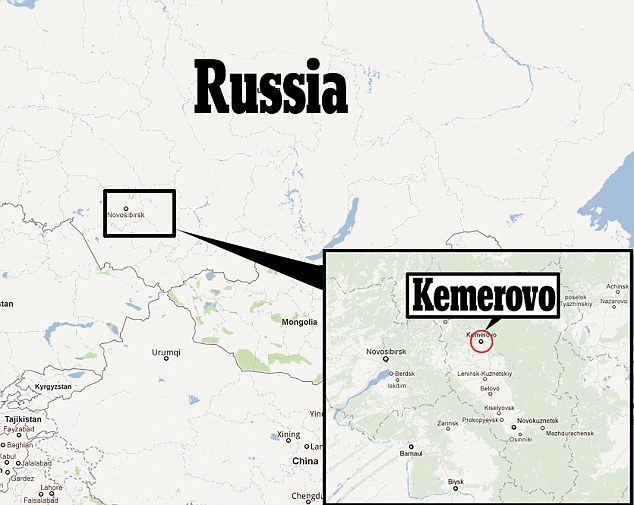

Sasquatch in Siberia?
Hair found in Russian cave 'belonged to unknown mammal closely related to man'
By Will Stewart
Mail Online
October
30, 2012
Source
• Mysterious mammal more closely related to man than to monkeys
Astonishing claims were made in Russia today that DNA tests on suspected 'Yeti hair' reveals the existence of 'an unknown mammal closely related to man'.
The 'tests' were conducted on samples of hair found in a Siberian cave
during an international expedition last year.
'We had ten samples of hair to study, and have concluded that they belong to mammal,
but not a human,' said Professor Valentin Sapunov, of the Russian State Hydrometeorological Institute.
Nor did the hair belong to any known animal from the region such as a bear, wolf, or goat, he claimed.
Analysis was conducted in the Russia and US and 'agreed the hair came from a human-like creature which is not a Homo sapien yet is more closely related to man than a monkey', said the Siberian Times, citing claims made on a regional government website in Russia in the area where the hair samples were allegedly found.
It stated that long-awaited scientific tests were conducted on their hair at two institutions in Russia and one in Idaho in the US.
'All three world level universities have finished DNA analysis of the hair and said that the hair belongs to a creature which is closer by its biological parameters to Homo sapiens than a monkey. The Yeti's DNA is evidently less than one per cent different to that of a human.'
The
tests were undertaken on hair found one year ago in the Azasskaya Cave in the Mourt Shoriya area of Kemerovo region in Siberia, it
was alleged.
The 2011 expedition to the remote cave complex in Kemerovo when the alleged Yeti hair was found was led by Dr Igor Birtsev, seen as Russia's leading advocate of the existence of the abominable snowman.
He last night questioned the conclusions saying he was seeking more information about the alleged tests.
The Siberian Times said only
'scant' details were made available of the 'DNA findings'.
Sapunov claimed that the prestigious Zoological Institute of Russian Academy
of Sciences was involved in the tests.
Yeti 'sightings' have been reported for centuries in most continents but the creature has evaded
capture and no remains have ever been discovered.
Several 'sightings' of yetis have been made recently according to a Russian official
and fishermen in Siberia.
'We shouted to them - do you need help?,' said fisherman Vitaly Vershinin.
'They just rushed away, all in
fur, walking on two legs, making their way through the bushes and with two other limbs, straight up the hill.'
He continued: 'What
did we think? It could not be bears, as the bear walks on all-fours, and they ran on two.... so then they were gone.'
Russia's leading
researcher on yetis, Igor Burtsev claims around 30 of the 'abominable snowmen' live in the Kemerovo region, where these sightings
were.


Yeti Evidence Falls Flat: Scientist Says Local Officials Staged Siberian Snowman Hunt For Publicity
It
was a very awkward feeling because here I was a guest and this was clearly orchestrated," said Idaho State University anthropologist
and anatomist Jeffrey Meldrum.
"I thought that was kind of odd, and then someone picked up a little tuft of hair that was apparently
pressed into the footprint. At that point, I wasn't comfortable with the situation and had an inkling of what might be happening,"
Meldrum said.
Adding to his growing feeling that the entire situation was a setup, the respected American scientist said that the trail
leading to the cave had been well maintained and showed signs of being frequently visited, including graffiti on the cave walls, remnants
of some campfires and discarded trash.
It was at this point that Meldrum said he realized that everything that happened in the alleged
Yeti lair was likely completely staged for his and the media's benefit. The publicity certainly wouldn't hurt Kemerovo's skiing tourism
activities.


(Born 1958) is an Associate Professor of Anatomy and Anthropology and Adjunct Associate Professor of the Department
of Anthropology at Idaho State University. Meldrum is also Adjunct Professor of Occupational and Physical Therapy and Affiliate Curator
of Vertebrate Paleontology at the Idaho Museum of Natural History.
Meldrum is an expert on foot morphology and locomotion in primates.

'They have an acute sense of danger'
Yeti expert defends lack of sasquatch sightings as row erupts over his claims that 200 live in
Siberia
A row has erupted in Russia over a biological scientist's claim that
some 200 Yeti live in a large area of southern Siberia.
Professor Valentin Sapunov has infuriated academics with his assertion that
scientific tests, including DNA checks, found that hair samples from a remote cave belonged to a human-like mammal unknown to man.
Now
he has gone further by claiming a population of 200 Yeti exist in the forested Kemerovo, Khakassia and Altai regions of Siberia.
This
number allows them to successfully reproduce, said the academic from the Russian State HydroMeteorological University.
'He claims
there have been no confirmed sightings of the Yeti because they have an acute sense of danger,' reported the Siberian Times.
But other
Russian experts are deeply unimpressed by Professor Sapunov's theories, saying he has put his Big Foot in it with claims that there
is DNA backing for the existence of the Yeti.
Far from finding the Abonimable Snowman, his scientific claims on the subject amount
to abominable lies, Oleg Pugachev, director of the Zoological Institute of Russian Academy of Science, told state-run newspaper Rossiyskaya
Gazeta.
This institute was one of three where Professor Sapunov claimed the 'Yeti hair' - found a year ago - was tested.
Mr Pugachev
said: 'Let me make it clear - Sapunov is blatantly lying.
'He came with some bits of hair to the Institute, and spent a lot of time
in my office complaining that official science want nothing to do with it and no-one wants to test them.
'He asked me to help. I took a pity on him and ordered our DNA specialists to carry out a test.
'They did not manage to extract any
genealogical material because there were no hair bulbs.
'The structure of the hair showed that they could have belonged to a goat,
and a bear, and to other animals.
'That's the end of it. What Snowman is he talking about? If he ever appears close to our Institute
I will not let him anywhere near the doorstep.
'I don't know how to stop the rubbish he is spreading in the media.'
Svetlana Borinskaya,
a doctor of Biological Sciences at the Institute of General Genetics of the Russian Academy of Sciences, said: 'I know Sapunov personally.
He never worked with DNA - or if he did, I've never heard of such works.
'But I do know that he is obsessed with the Yeti since his
early years.'
If he had done serious work, he should have published it in a scientific journal, she added.
Professor Sapunov has hit
back, saying there is more evidence of the Yeti than for many officially documented species, some of which are reported to exist on
the basis of a single bone.
'Every science needs its Yeti,' he said, adding that Fermat's Last Theorem led to advancements in mathematics
for more than 350 years before it was solved in 1995.

Oleg Pugachev: “Let me make it clear - Sapunov is blatantly lying.”
Senior Scientific Researcher, Head of Department of parasitic worms,
Deputy director of the Zoological institute of Russian Academy of Sciences
PARASITOLOGY, ECOLOGY, ZOOGEOGRAPHY

Svetlana Borinskaya
She graduated from the Department of Molecular Biology, Faculty of Biology. Initiator and participant of Russian
and international projects integrating the humanities and natural approaches to the study of human evolution and why people are different.
Author of several scientific articles and winner of the competition for popularizing science.
Press secretary of the Institute of
General Genetics. NI Vavilov Sciences. Leading Researcher, Laboratory analysis of the genome of the same institute.